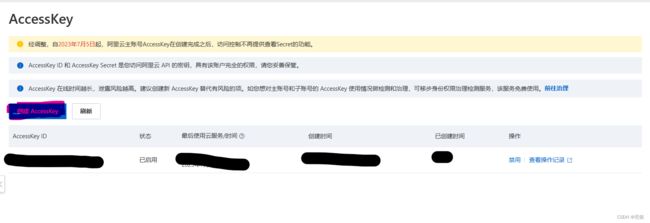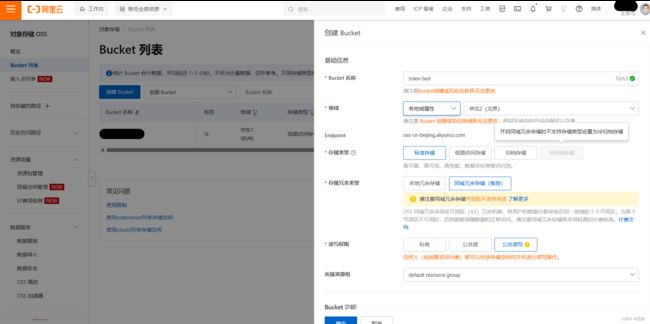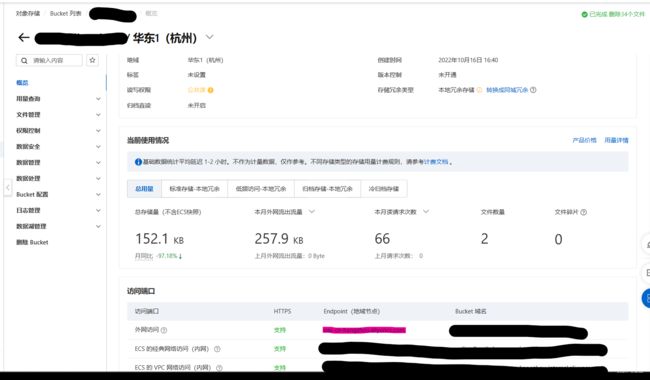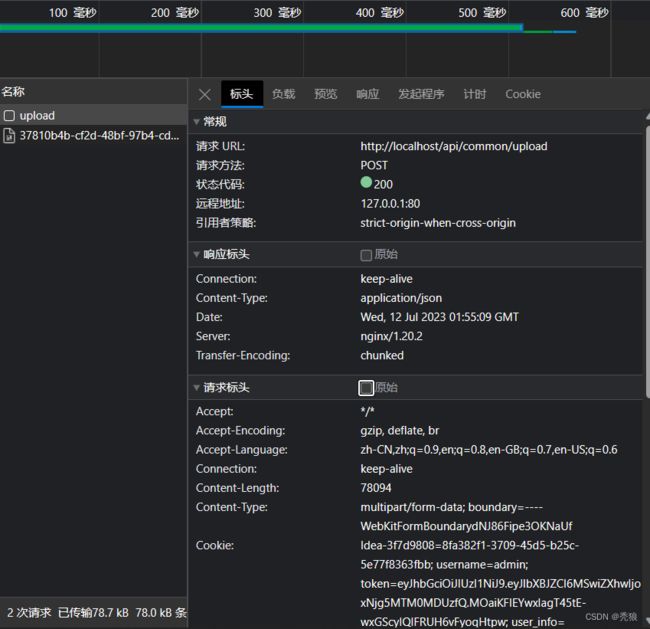阿里云OSS使用(小白也看得懂)
oss简介
oss是对象存储服务(Object Storage Service)的缩写,是一种分布式存储服务,用于存储和访问大规模数据。它提供了可靠、安全、低成本的数据存储解决方案,可以通过网络随时随地访问存储的数据。oss常用于存储图片、视频、文档等非结构化数据。
使用oss
导入依赖
com.aliyun.oss
aliyun-sdk-oss
3.10.2
创建对应的工具类AliOssUtil类,此代码是固定代码,直接CV即可。(类的名字无需固定)
import com.aliyun.oss.ClientException;
import com.aliyun.oss.OSS;
import com.aliyun.oss.OSSClientBuilder;
import com.aliyun.oss.OSSException;
import lombok.AllArgsConstructor;
import lombok.Data;
import lombok.extern.slf4j.Slf4j;
import java.io.ByteArrayInputStream;
@Data
@AllArgsConstructor
//固定代码,CV直接使用
public class AliOssUtil {
private String endpoint;
private String accessKeyId;
private String accessKeySecret;
private String bucketName;
/**
* 文件上传
*
* @param bytes :传入的文件要转为byte[]
* @param objectName :表示在oss中存储的文件名字。
* @return
*/
public String upload(byte[] bytes, String objectName) {
// 创建OSSClient实例。
OSS ossClient = new OSSClientBuilder().build(endpoint, accessKeyId, accessKeySecret);
try {
// 创建PutObject请求。
ossClient.putObject(bucketName, objectName, new ByteArrayInputStream(bytes));
} catch (OSSException oe) {
System.out.println("Caught an OSSException, which means your request made it to OSS, "
+ "but was rejected with an error response for some reason.");
System.out.println("Error Message:" + oe.getErrorMessage());
System.out.println("Error Code:" + oe.getErrorCode());
System.out.println("Request ID:" + oe.getRequestId());
System.out.println("Host ID:" + oe.getHostId());
} catch (ClientException ce) {
System.out.println("Caught an ClientException, which means the client encountered "
+ "a serious internal problem while trying to communicate with OSS, "
+ "such as not being able to access the network.");
System.out.println("Error Message:" + ce.getMessage());
} finally {
if (ossClient != null) {
ossClient.shutdown();
}
}
//文件访问路径规则 https://BucketName.Endpoint/ObjectName
StringBuilder stringBuilder = new StringBuilder("https://");
stringBuilder
.append(bucketName)
.append(".")
.append(endpoint)
.append("/")
.append(objectName);
return stringBuilder.toString();
}
}
在该工具类中有四个属性,这些属性需要我们手动在application.yml中配置,这里我们就创建一个Prperties类,用于从application.yml中获取oss的配置属性。
AliOssProperties类
import lombok.Data;
import org.springframework.boot.context.properties.ConfigurationProperties;
import org.springframework.stereotype.Component;
@Component
//通过此注解我们就可以通过已sky.alioss为其中在application.yml中配置这四个属性
@ConfigurationProperties(prefix = "sky.alioss")
@Data
public class AliOssProperties {
private String endpoint;
private String accessKeyId;
private String accessKeySecret;
private String bucketName;
}
application.yml的配置
sky:
alioss:
access-key-id: xxxxx
access-key-secret: xxxxx
bucket-name: xxxxx
endpoint: $xxxxx accessKeyId和accessKeySecret都在阿里云网站上的个人中心中配置和查询。
bucketName在bucket列表中配置和查询。
创建bucket为下配置,且bucketName必须唯一。
endpoint的查询
此时我们已经创建好了工具类,接下来我们要将工具类配置到ioc容器中,便于后续的使用。
创建oss对应的配置类。
import com.sky.properties.AliOssProperties;
import com.sky.utils.AliOssUtil;
import org.springframework.boot.autoconfigure.condition.ConditionalOnMissingBean;
import org.springframework.context.annotation.Bean;
import org.springframework.context.annotation.Configuration;
@Configuration
public class OssConfiguration {
@Bean
@ConditionalOnMissingBean
public AliOssUtil getAliOssUtil(AliOssProperties aliOssProperties) {
log.info("创建OssUtil");
AliOssUtil aliOssUtil = new AliOssUtil(
aliOssProperties.getEndpoint(),
aliOssProperties.getAccessKeyId(),
aliOssProperties.getAccessKeySecret(),
aliOssProperties.getBucketName()
);
return aliOssUtil;
}
}此后我们使用AliOssUtil只需要在使用时进行依赖注入即可。
测试
创建控制层
@RestController
@RequestMapping("admin/common")
public class CommonController {
@Autowired
private AliOssUtil aliOssUtil;
@PostMapping("/upload")
//请求中要携带上需要上传的文件
public Result saveOss(MultipartFile file) {
try {
// 获取原始的文件名
String originalFilename = file.getOriginalFilename();
//在oss中存储名字就是UUID + 文件的后缀名
String objectName = UUID.randomUUID() + originalFilename.substring(originalFilename.lastIndexOf("."));
String resultURL = aliOssUtil.upload(file.getBytes(), objectName);
return Result.success(resultURL);
} catch (IOException e) {
throw new RuntimeException(e);
}
}
} 进行测试,发送请求。
请求成功,在oss中查看存储的图片文件。
上传成功。
总结
oss服务多使用在用户头像的上传上等需要存储图片数据的接口上,因为配置代码是固定的,所以在使用过程中我们只需要看得懂配置即可,在后续的使用中也只需要从本博客中CV即可。




